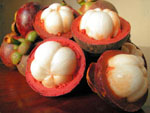
Uses and Food Value
Its composition taken from the 1990 edition of the Food Composition Table prepared by the Food and Nutrition Research Institute is as follows. The pulp, which is very light and soft and has an exquisite flavor, is best eaten fresh, preferably after chilling the fruit. The pulp and seed, when boiled with sugar, make an excellent preserve or topping for ice cream or sherbet. The seeds have a delicious nutty flavor. The leaves and bark, claimed to be medecinal, are used as astringent to cure aphtha or thrush. They are also used as a febrifuge or antipyretic while the pericarp is regarded as very effective in curing chronic intestinal catarrh.
The pericarp contains 7-15% tannin and it is used for dyeing. A decoction of the root may be taken to achieve regular menstruation. Leaf infusion is applied to wounds and a decoction of the pericarp may be administered to cure dysentery or simply used as alotion. Dried rind is used as an astringent. The seed contains about 30% of valuable oil.
SOIL AND CLIMATIC REQUIREMENTS
Mangosteen thrives best in warm, humid environment. Ideal temperature is 20°C-30°C. A temperature of less than 20°C slows down growth. Ideally, rainfall should be well distributed throughout the year, but trees are known to grow successfully even under dry conditions with irrigation. The soil should be rich, porous, deep and wet but well drained. Heavy clay with a generous admixture of sand and silt, and a water table of about two meters are best. It also grows well up to an elevation of zero to 500 meters. The tree also thrives well along river banks, canals, ponds and lakes. It grows best in areas with a well distributed rainfall.
CULTURE AND MANAGEMENT
A. Land Preparation Before planting, condition the land and make it fit for the reception of the trees. In clearing, all tree stumps should be removed along with as many roots as possible. If a mangosteen orchard is to be established, land preparation follows the system for other fruit crops. This consists of deep plowing once and twice, followed by several harrowings, until the desired soil tilth is attained. Stakes are set at a distance of 8-10m corresponding to the recommended distance of planting for mangosteen. Holes are then dug at the positions occupied by the stakes where mangosteen seedlings are set and covered with soil.
B. Sowing the seeds and care of the seedlings Seeds are sown inseed boxes, seed flats or pots, bamboo tubes or plastic bags, under a cover. In a week or two, the seeds sprout and the seedlings are to be kept in a nursery under partial shade and watered 3 to 4 times a week. Usually, the seedlings take about two years to become large enough for transplanting to a permanent field. At this stage, the plants are about 30 cm tall.
C. Planting and Spacing Mangosteen seedlings are ready to be transplanted to the field when they are two years old, at which age, they are about 25-30 cm tall. The seedlings are to be carefully removed from the containers and set in the holes to avoid disturbing the root system. The most suitable period to transplant is just after the rainy season has set in. Planting in an area where there are light shimmers is very helpful in ensuring satisfactory establishment of the young plants. On level land, the trees are planted using the square system: spacing of at least 8m x 8m between rows and between trees in a row. some 156 seedlings to a hectare are needed. The size of the holes should be 0.6m x 0.6m x 0.6m and filed with farm manure. Plants are then set out at the center of the hole. Gradually fill-in the hole with loose top soil. Gently press the soil until it firmly grips the plant.
D. Weeding and Cultivation Ring-weeding at one meter radius and loosening the earth are practiced to preserve the fertility of the soil, as well as to allow the development of the plants. Areas between rows are plowed for better weed control and cultivation.
IRRIGATION
Artificial irrigation is practiced during dry months. Water the plants as soon as they are transplanted and sustain during the times when precitation is not adequate in order to keep the soil moisture at a high level. In the seedling stage, however, standing water over the roots can kill the plant outright.
FERTILIZATION
Mangosteen trees respond well to manuring. Diluted organic fertilizer which can be absorbed slowly is desirable. Also, application of a nitrogenous fertilizer can accelerate vegetative growth of the plants. Fertilizer application varies with the age of the plant. Since ammonium sulfate is applied at planting time, succeeding application should follow a circular outline following the tree’s canopy. Dig 4 to 6 holes following the circular plan on the ground. Put the fertilizer into the holes, cover to prevent volatilization, and to reduce run- off in case of heavy rains. At planting time, apply 200-250 grams complete fertilizer per tree three inches below the roots and five inches at the side of the seeding. For young trees, mix and apply in two equal dosages 300-500 grams 14-14-14 or 12-24-12 and broadcast or apply, by digging a shallow furrow around each tree, 200-300 grams urea (45-0-0).
Apply the first dosage at the start of the rainy season and the second dosage at the end of the rainy season. During the fruit-bearing stage, mix then apply in two equal doses 1.5 to 3.0 kg 14-14-14 or 12-24-12 plus 200- 300 grams Muriate of Potash (0-0-60). Apply in same manner as that for young trees. Gradually increase the amount of fertilizer very year as the trees grow bigger and as fruit production increases.
INTERCROPPING AND COVER CROPPING
Planting intercrops and cover crops in the mangosteen orchard is more or less confined to the early years because, as the trees develop in size and status, not much unshaded space is left in between rows for their proper growth. Mangosteen, in Sulu Archipelago, is usually planted with intercrops or peanut and other leguminous field crops, or with companion plants like abaca and banana, or marang and lansones trees. other crops that may be intercroped also are “dapdap” or durian trees which can serve as partial shades.
PEST AND DISEASES
Mangosteen is subject to several pests, the most common of which are mites, aphids, fructifier ants and mealy bugs. Others, such as tussock caterpillars feed on the leaves while coconut scales form colonies under neath the leaves which causes leaf yellowing in patches thus impairing plant growth. Occasionally, sooty molds are found covering the leaves. Diseases due to anthracnose and bacterial leaf sheath have also been reported. As a preventive measure, the plants may be sprayed two four time a year with common fungicides at dosages recommended. Read the label before application.
HARVESTING, CURING AND STORING
Mangosteen usually flowers in 10 to 15 years but if given proper care, asexually propagated trees bear fruit in eight to nine years. It takes about five to six months from flowering stage to fruit ripening. Harvesting is normally done from the month of August to October. The fruit is mature when its color changes from greenish brown to reddish purple and when it is rather soft to the touch. Great care must be practiced when harvesting fruits. Be sure that the fruits are mature at harvest time, otherwise, they may fail to develop an excellent flavor. Handle the fruits with great care while harvesting. Handpicking is a good method since the pericarp, which is still slightly soft at harvest is easily subjected to injury when the fruits falls. As an alternative method use a long pole with a hook at the tip and a catching basket attached at the end where the fruits will be collected. The method of harvesting employed in Sulu is hand picking the fruit with its preduncle intact. Fruits are then bound together in elongated clusters of 15 pieces.
MEDICINAL USE
DIARRHEA – Boil the required amount of seeds in two glasses of water for 15 minutes, or until only 1/2 of the liquid is left. Cool and strain. Divide the decoction into four plants. drink one part every 2 to 3 hours. Packed in sterilized bottles.
Adult – 4 tsp
7-12 yrs. Old – 2 tsp
2-6 yrs. Old – 1 tsp
For children 7-12 years, use half of the adult dose.
PROCESSING POSSIBILITIES MANGOSTEEN PRESERVE
Ingredients:
200 pieces mangosteen
1 kilo sugar
Procedure:
1. Remove the pericarp. Apply pressure with the thumb to remove the seeds.
2. Add 1 kilo white sugar to the fruits.
3. Boil for 35 to 50 minutes with constant stirring until the concoction turns light brown.
Packed in sterilized bottles.
Referrences:
1. Alakbar, P. 1971, Culture of Mangosteen, Special Report on the Culture of Mangosteen Based on the Practice employed in the Province of Sulu
BPI, Sulu.
2. Guide in Mangosteen Growing, 1985 Bureau of Plant Industry, Manila.
3. Preservation of Fruits and Vegetables 1988 Revised edition, Laboratory Service Division, BPI, Manila
Source: http://www.da.gov.ph




Mangosteen is a fruit from Asia to be very popular. Mangosteen has been dubbed. “Queen of Fruits”, which is useful in helping to neutralize free radicals.